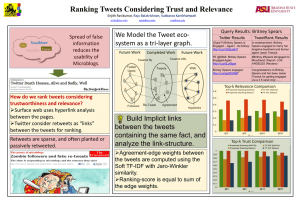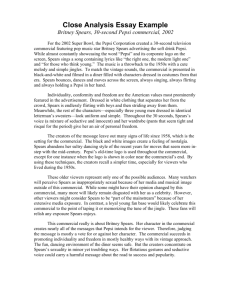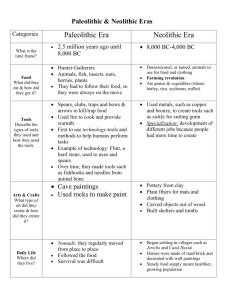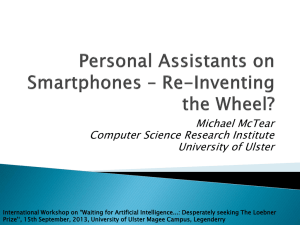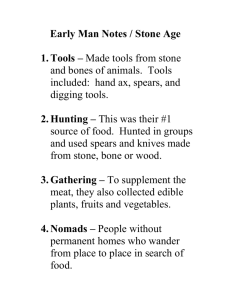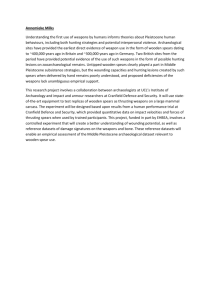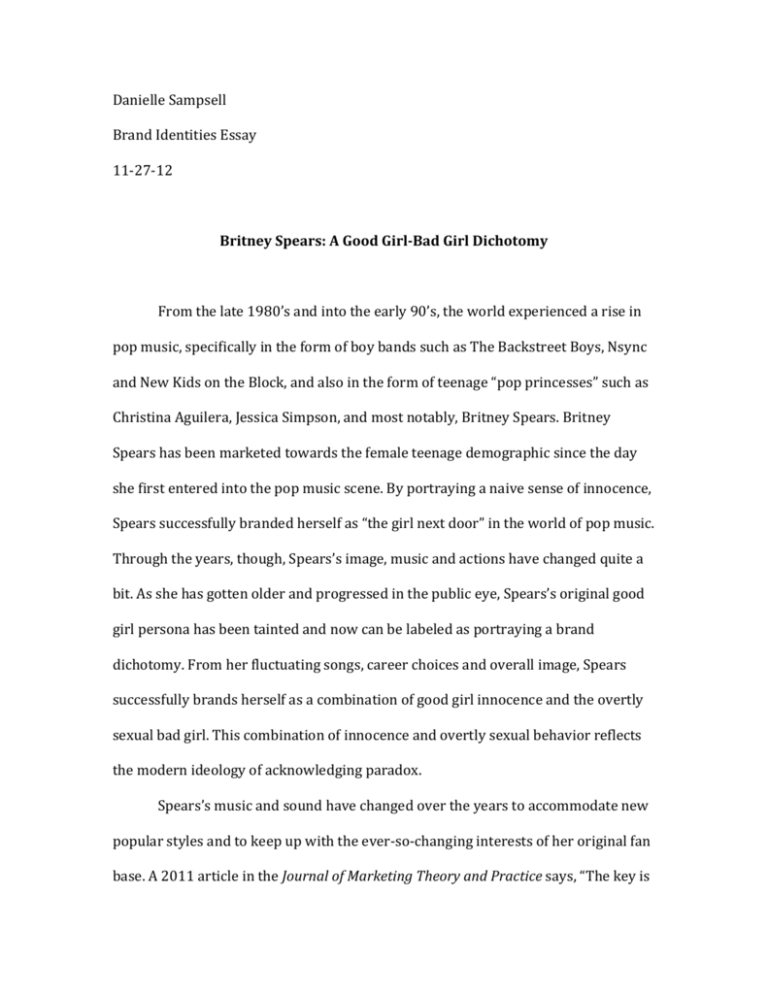
Danielle Sampsell Brand Identities Essay 11-­‐27-­‐12 Britney Spears: A Good Girl-­‐Bad Girl Dichotomy From the late 1980’s and into the early 90’s, the world experienced a rise in pop music, specifically in the form of boy bands such as The Backstreet Boys, Nsync and New Kids on the Block, and also in the form of teenage “pop princesses” such as Christina Aguilera, Jessica Simpson, and most notably, Britney Spears. Britney Spears has been marketed towards the female teenage demographic since the day she first entered into the pop music scene. By portraying a naive sense of innocence, Spears successfully branded herself as “the girl next door” in the world of pop music. Through the years, though, Spears’s image, music and actions have changed quite a bit. As she has gotten older and progressed in the public eye, Spears’s original good girl persona has been tainted and now can be labeled as portraying a brand dichotomy. From her fluctuating songs, career choices and overall image, Spears successfully brands herself as a combination of good girl innocence and the overtly sexual bad girl. This combination of innocence and overtly sexual behavior reflects the modern ideology of acknowledging paradox. Spears’s music and sound have changed over the years to accommodate new popular styles and to keep up with the ever-­‐so-­‐changing interests of her original fan base. A 2011 article in the Journal of Marketing Theory and Practice says, “The key is to maintain the image while altering the product, consistently, to fit the always changing popular styles,” (Society for Marketing Advances, 2011). Britney and her team manage to successfully do this by maintaining the balance of overtly sexual content and of more innocent content within her messages and lyrics in the songs. Her debut album in 1999 with Jive Records, “…Baby One More Time,” became the best-­‐selling album by a teenage solo artist. Within her first album alone, Spears offers a lyrical balance. Her hit single, “…Baby One More Time,” topped the Billboard Hot 100 chart in 1999 and is an example of a song with controversial lyrics suggesting submissiveness towards men as well as overtly sexual behavior (Britney Spears Billboard). Specific lyrics in the song that demonstrate this are: “show me how you want it to be, hit me baby one more time.” These lyrics alone clearly demonstrate Britney’s “bad girl” side and the desire for male physical attention. In contrast, on the same album Britney’s song “Sometimes” is reflective of a shy, more innocent Britney. In this song she sings, “There’s nowhere I’d rather be, if you love me trust in me the way that I trust in you.” These lyrics alone exemplify Britney’s “good girl next door” side and allow her to personify innocence. 11 years after Spears’ first album she released her 7th album entitled “Femme Fatale.” This record was no different in that it still has a lyrical contrast between innocence and sexual appeal. Her hit “Till The World Ends,” is a free, fun and innocent dance song for all to enjoy. The lyrics repeat over and over “keep on dancing till the world ends,” which is clearly not in reference to anything sexual at all. This, however, greatly contrasts her song “I Wanna Go,” which is obviously about fulfilling her inner sexual desires. The lyrics, which are, “I wanna go all the way, taking out my freak tonight, I wanna show all the dirt I got running through my mind,” clearly are a contrast to her innocent side and go along with her more overtly sexual bad girl image. The evident brand dichotomy between “the girl next door” good girl image and the overtly sexual bad girl image of Britney Spears is also made clear through her music videos she has done over the years. In her music video for her chart-­‐
topping hit, “Toxic,” Britney is seen in numerous skimpy and revealing outfits; she wears a black leather body suit, a short blue flight attendant dress and also even wears nothing but glitter in one of the scenes (Britney Spears YouTube). Not only her clothing choices but also her actions in this video show off her flirtatious, bad girl side. Three separate times in the video she is seen kissing men or fondling with their body. In contrast, Britney’s music video for “Everytime,” on the same album as “Toxic,” shows her wandering throughout a hospital singing the lyrics of the depressing and innocent song. While in the hospital, Britney is seen wearing jeans and a sweater for the majority of the time until the end when she also has a coat on (Britney Spears YouTube). Between these two music videos alone, the paradox of her brand identity is clearly visible not only through her clothing choices but also through her actions. The look and style as well as contents of Spears’ website also contribute to the good girl/ bad girl dichotomy brand identity she has created for herself. When first arriving at the website, the layout is divided; the site has a close-­‐up image of Britney’s face in the center and then has links down the right and left for viewers to choose from. Along with the clear two-­‐sided website comes its contents. Shirts in the online store mostly all have seductive images of Britney on them, and if not, then they have images of the younger and more innocent Britney covering them. Similarly, the website layout and background changes between each kind of merchandise item or image in her gallery. For the more mature and sexual content, the site background is an image of Britney with her hands in her hair and gritting her teeth in a seductive looking way. But, for the more relaxing and carefree content, the site background is an image of Britney in her Catholic schoolgirl “…Baby One More Time” video costume (Britney Spears Official Website). Her YouTube website also plays off of her dual image. When arriving at her YouTube home page, one will see a purple and pink sparkling background with an image of Britney in tight black leggings and a crop top sporting a natural smile. This layout, alone, shows her paradoxical brand identity. Her smile and body language clearly portray a sense of innocence, while her clothing and color schemes give off a slight air of maturity and sexuality (Britney Spears Official YouTube). Not only do the images on her website convey the obvious paradox, but the images on her albums and tour covers do as well. For all seven of her albums, Spears’s covers predominantly picture her with a close-­‐up and either a smile or a somewhat seductive-­‐looking facial expression. They do not picture her with over-­‐
the-­‐top revealing or inappropriate clothing. However, as soon as the CD image booklet is removed from the case, more overtly sexual images of Spears can be found throughout the different pages. This example of CD artwork, alone, demonstrates the clear dueling identity Britney Spears presents to her fans and the general public. In contrast, almost all of Spears’s tour posters and designs feature her in overtly sexual clothing and portraying more provocative facial expressions and body language. For example, her Britney Spears Circus tour poster has an image of her on her knees in a leotard with her hands ruffling her hair and biting her lip. This clearly portrays her more provocative and sexual brand identity as compared to the other side of innocence she tends to portray as well (Britney Spears Official Website). All musical endeavors aside, Spears successfully maintains her brand identity dichotomy through her other works such as movies, commercials and products. Her film debut was made in 2002 in the comedy-­‐drama “Crossroads” about three friends who take a trip across the United States in hopes to pursue their acting dreams. Throughout this film, Spears is considered the shy but yet very sexual friend. She doesn’t seem to offer much opinion on much towards her friends but, yet, she is the first of the three girls to lose their virginity and to be most comfortable with her sexuality. “Crossroads” allows Spears to maintain her naïve, good girl image while also allowing her to keep her dueling bad girl side as well. Spears, a long time endorser for Pepsi, and vice versa, has also maintained her paradoxical brand identity through each of her projects with the Pepsi Company. In the numerous commercials for Pepsi, Spears sings the Pepsi theme song “Joy of Pepsi”, created specifically for her, while dancing in typically revealing and sexual clothing, with a Pepsi in hand. Aside from the multiple commercials she has done for Pepsi, she has also been featured on numerous Pepsi advertisements and posters. Her dueling brand identity remains clear throughout these. An example of this would be two billboard ads, which ran in 2007. The first one depicts Spears sporting a 50s hairstyle and conservative clothing while drinking a Pepsi; this clearly shows off her more reserved and innocent side. But, the second ad shows Spears in a midriff top and short skirt drinking a Pepsi with almost her entire torso showing; this clearly shows off her sexual, more mature side (Britney Spears YouTube). Although Spears has been in the public eye for 14 years, she has still been marketed and appealed to the same audience: teenage girls. Spears is someone many teenage girls have looked up to not necessarily as a role model, but more so as an image they wish to have: hot, sexy and yet still innocent. Spears appeals to the physical and emotional desire of these teens through her overall desirable image as well as through her song lyrics. But yet, many of these teenage girls still disapprove of her brand image dichotomy and find it difficult to buy into Spears’s good “girl next door” side. Melanie Lowe, assistant professor of Musicology at Vanderbilt University, published her findings from a female teenage focus group on Britney Spears in a 2003 article in Popular Music and Society. Lowe found that all of the girls involved were Spears fans but they found her dueling image hard to believe and it even angered them. “But ultimately, in what turns out to be quite a sophisticated reading of these texts, they are not bothered by Spears's assumption of either the ''whore'' or the ''Catholic school girl'' persona individually. Rather, the girls are bothered by a clash of the two personae: a conflict of signifieds within the same frame,” (Lowe, 2003). Clearly it is evident that although Spears’s fans support her and all of her projects, they can still see the identity she has created. It is most interesting that although Spears does have the dueling good girl/ bad girl identity, her teenage fan base understands that the image is almost all it is. The overtly sexual messages do not come with any deep meaning for the audience and the girls are therefore able to distinguish what is entertainment from what is reality and acceptable in day-­‐to-­‐day society. All in all, Spears’s dichotomy of “girl next door” good girl and the overtly sexual bad girl identity works well to maintain her reputation, fan base and overall image. Her many songs, videos, album artwork, movies and commercials all help to aid her in the keeping up of her identity. The Britney Spears brand has been present for almost 14 years now and is still consistent in all its endeavors. Although no longer quite considered a “pop princess,” Spears is still projecting herself as the innocent yet overtly sexual women she wants everyone to believe that she is. The paradoxical identity is something all listeners and viewers can easily recognize and also support Spears in, because of its continual consistency. WORKS CITED “Britney Spears, Billboard.” Billboard. http://www.billboard.com/artist/britney-­‐ spears/290150#/artist/britney-­‐spears/chart-­‐history/290150 (accessed November 25, 2012) “Britney Spears Official Site.” Britney Spears Official Site. http://www.britneyspears. com/index (accessed November 25, 2012) “Britney Spears YouTube Channel.” Britney Spears YouTube Channel. http://www.youtube.com/user/BritneySpears (accessed November 25, 2012) Lowe, Melanie. "Colliding Feminisms: Britney Spears, "Tweens," and the Politics of Reception." Popular Music and Society 26.2 (2003): 123-­‐40. International Index to Music Periodicals Full Text. 2 Dec. 2012 "Society For Marketing Advances." Journal Of Marketing Theory & Practice 19.4 (2011): 475-­‐476. Business Source Complete. Web. 2 Dec. 2012.


